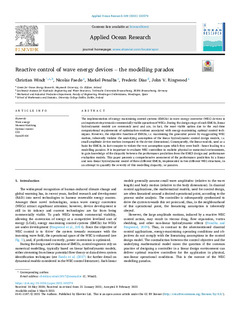| dc.rights.license | Attribution 4.0 International | |
| dc.contributor.author | Penalba, Markel | |
| dc.contributor.other | Windt, Christian | |
| dc.contributor.other | Faedo, Nicolás | |
| dc.contributor.other | Dias, Frederic | |
| dc.contributor.other | Ringwood, John V. | |
| dc.date.accessioned | 2021-03-29T13:13:33Z | |
| dc.date.available | 2021-03-29T13:13:33Z | |
| dc.date.issued | 2021 | |
| dc.identifier.issn | 0141-1187 | en |
| dc.identifier.other | https://katalogoa.mondragon.edu/janium-bin/janium_login_opac.pl?find&ficha_no=163154 | en |
| dc.identifier.uri | https://hdl.handle.net/20.500.11984/5262 | |
| dc.description.abstract | The implementation of energy maximising control systems (EMCSs) in wave energy converter (WEC) devices is an important step towards commercially viable operation of WECs. During the design stage of such EMCSs, linear hydrodynamic models are commonly used and are, in fact, the most viable option due to the real–time computational requirements of optimisation routines associated with energy-maximising optimal control techniques. However, the objective function of EMCSs, i.e. maximising the generated power by exaggerating WEC motion, inherently violates the underlying assumption of the linear hydrodynamic control design models, i.e. small amplitude device motion (compared to the device dimensions). Consequently, the linear models, used as a basis for EMCSs, in fact conspire to violate the very assumption upon which they were built - hence leading to a modelling paradox. It is important to evaluate WEC controllers in realistic physical or numerical environments, to gain knowledge of the disparity between the performance prediction from the EMCS design and performance evaluation models. This paper presents a comprehensive assessment of the performance prediction by a linear and non–linear hydrodynamic model of three different EMCSs, implemented in two different WEC structures, in an attempt to quantify the severity of this modelling disparity, or paradox. | en |
| dc.language.iso | eng | en |
| dc.publisher | Elsevier Ltd. | en |
| dc.rights | © 2021 The authors | en |
| dc.rights.uri | http://creativecommons.org/licenses/by/4.0/ | |
| dc.subject | Wave energy | en |
| dc.subject | Moment-Matching | en |
| dc.subject | Optimal control | en |
| dc.subject | CFD | es |
| dc.subject | OpenFOAM | en |
| dc.title | Reactive control of wave energy devices – the modelling paradox | en |
| dc.type | http://purl.org/coar/resource_type/c_6501 | |
| dcterms.accessRights | http://purl.org/coar/access_right/c_abf2 | en |
| dcterms.accessRights | http://purl.org/coar/access_right/c_abf2 | |
| dcterms.source | Applied Ocean Research | en |
| local.contributor.group | Mecánica de fluidos | es |
| local.description.peerreviewed | true | en |
| local.identifier.doi | https://doi.org/10.1016/j.apor.2021.102574 | en |
| local.contributor.otherinstitution | https://ror.org/048nfjm95 | es |
| local.contributor.otherinstitution | https://ror.org/010nsgg66 | es |
| local.source.details | Vol, 109. N. artículo 102574, 2021 | en |
| oaire.format.mimetype | application/pdf | |
| oaire.file | $DSPACE\assetstore | |
| oaire.resourceType | http://purl.org/coar/resource_type/c_6501 | en |
| oaire.version | http://purl.org/coar/version/c_970fb48d4fbd8a85 | en |








